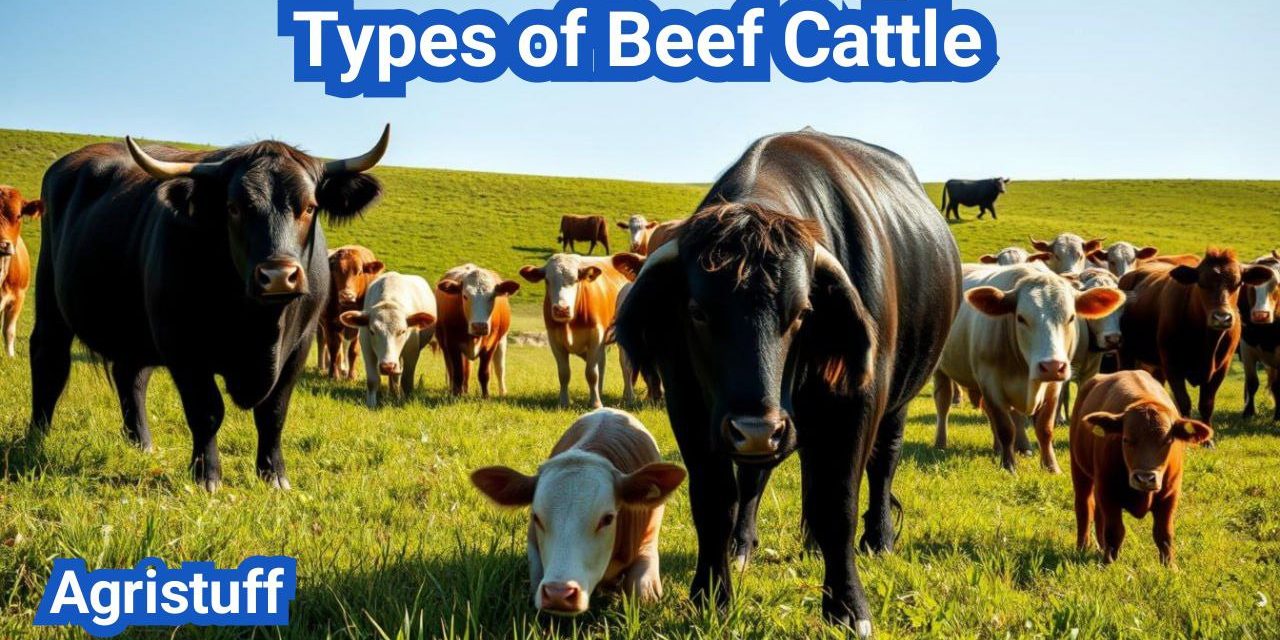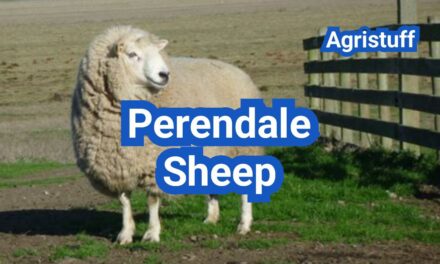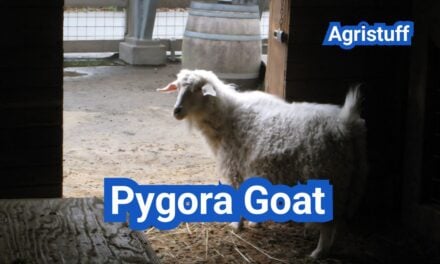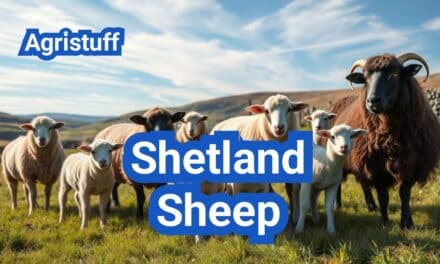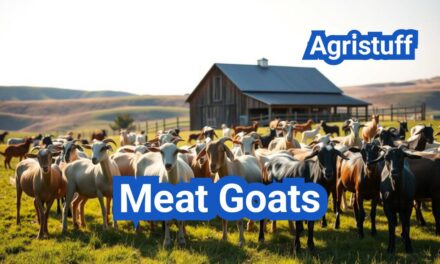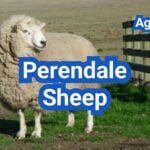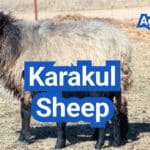With over 250 recognized breeds of cattle worldwide, selecting the right beef cattle breed can be a daunting task for producers. In the United States alone, there are more than 80 breeds available, each with unique characteristics and advantages.
Understanding the different kinds of beef cattle and their traits is essential for successful beef farming. Various breeds are suited to different climates, production systems, and market demands. By choosing the most appropriate breed, farmers can improve the efficiency and profitability of their operations.
Key Takeaways | Types of Beef Cattle
- Over 250 recognized breeds of cattle exist worldwide.
- More than 80 breeds are available to producers in the United States.
- Different breeds have unique characteristics and advantages.
- Choosing the right breed is crucial for successful beef farming.
- Various breeds are suited to different climates and production systems.
- Selecting the appropriate breed can improve efficiency and profitability.
Understanding Beef Cattle Production
With over 28.2 million beef cattle, the U.S. beef industry is a powerhouse in the country’s agricultural landscape. Beef cattle production plays a vital role in American agriculture, contributing significantly to the national economy through job creation, land use, and export revenues.
The Importance of Beef Cattle in American Agriculture
Beef cattle are an integral part of American agriculture, utilizing vast grazing lands that might otherwise be unsuitable for other forms of farming. The industry supports rural communities by providing employment opportunities and stimulating local economies. Moreover, beef cattle production contributes to the country’s food security by supplying high-quality protein to both domestic consumers and international markets.
Economic Impact: The beef cattle industry has a substantial economic impact, with the value of cattle and calves sold annually running into billions of dollars. This not only benefits farmers and ranchers directly but also supports related industries such as feed suppliers, veterinary services, and equipment manufacturers.
Key Differences Between Beef and Dairy Cattle | Types of Beef Cattle
While both beef and dairy cattle are crucial components of the livestock industry, they are bred and managed for different purposes. Beef cattle are primarily raised for meat production, whereas dairy cattle are bred for their milk.
Breeding and Management: Beef cattle breeds are selected for their growth rate, muscle mass, and carcass quality. In contrast, dairy cattle are chosen for their milk production capacity. Management practices also differ, with beef cattle often being raised on pasture or in feedlots, whereas dairy cattle require more intensive management, including regular milking and specialized nutrition.
| Characteristics | Beef Cattle | Dairy Cattle |
|---|---|---|
| Primary Purpose | Meat Production | Milk Production |
| Breeding Focus | Growth Rate, Muscle Mass | Milk Yield, Lactation Persistence |
| Typical Breeds | Angus, Hereford, Simmental | Holstein, Jersey, Guernsey |
| Management Practices | Pasture or Feedlot | Intensive Milking and Nutrition Management |
The distinction between beef and dairy cattle is not just about their end product; it extends to their genetics, nutrition, and overall management. Understanding these differences is crucial for producers, policymakers, and consumers alike to appreciate the complexities of the livestock industry.
Types of Beef Cattle: Classification and Categories

Beef cattle breeds are diverse and can be classified based on their geographical origin and functional characteristics. This classification helps producers and farmers understand the strengths and weaknesses of different breeds, enabling them to make informed decisions.
British vs. Continental vs. Exotic Breeds | Types of Beef Cattle
Beef cattle can be broadly categorized into British, Continental, and Exotic breeds. British breeds, such as Angus and Hereford, are known for their high-quality beef and are often used in crossbreeding programs to improve the quality of the herd.
Continental breeds, including Charolais and Limousin, are recognized for their rapid growth rate and muscular development. Exotic breeds, like Wagyu and Highland, offer unique characteristics that can enhance the genetic diversity of a cattle operation.
- British breeds are known for their marbling and beef quality.
- Continental breeds are favored for their size and growth rate.
- Exotic breeds bring unique traits and genetic diversity.
Classification by Purpose: Maternal, Terminal, and Dual-Purpose | Types of Beef Cattle
Beef cattle can also be classified based on their purpose within a production system. Maternal breeds are selected for their reproductive efficiency and mothering ability, ensuring a strong foundation for the herd.
Terminal breeds are used for their growth and carcass traits, making them ideal for finishing programs aimed at producing high-quality beef. Dual-purpose breeds offer a balance between maternal traits and growth characteristics, providing flexibility for producers.
- Maternal breeds are chosen for their reproductive capabilities.
- Terminal breeds are valued for their growth and carcass quality.
- Dual-purpose breeds balance maternal and growth traits.
Understanding these classifications is essential for beef cattle producers to select breeds that align with their production goals and management practices.
British Beef Cattle Breeds
Among the most celebrated beef cattle breeds are those originating from Britain, known for their superior quality and hardiness. British beef cattle breeds have played a pivotal role in the development of the global beef industry, thanks to their desirable traits and adaptability to various production systems.
Angus Cattle: Black and Red Varieties | Types of Beef Cattle
Angus cattle, including both Black Angus and Red Angus, are among the most popular British breeds used in beef production worldwide. Known for their high-quality beef, Angus cattle are prized for their marbling ability, which enhances the tenderness and flavor of the meat. The Black Angus variety is particularly renowned for its premium beef, while Red Angus offers similar benefits with added hardiness in some environments.
Hereford and Polled Hereford | Types of Beef Cattle
Hereford cattle, both horned and polled varieties, are another significant British breed that has made a lasting impact on the beef industry. Originally from Herefordshire, England, these cattle are recognized for their hardiness, ease of handling, and high-quality beef. The Polled Hereford, a variation without horns, has gained popularity due to its reduced risk of injury to both the animal and handlers.
Shorthorn Cattle | Types of Beef Cattle
Shorthorn cattle, with their origins in Northeast England, are a versatile breed known for their beef production capabilities and maternal traits. Shorthorns are praised for their milking ability, making them suitable for crossbreeding programs aimed at improving milk production in beef herds. They are available in both horned and polled forms, offering flexibility for producers.
These British breeds have not only contributed significantly to the global beef industry but continue to be favored by producers due to their desirable production traits and adaptability. By understanding the characteristics and advantages of these breeds, producers can make informed decisions about their cattle operations.
Continental European Beef Breeds

European cattle breeds, such as Charolais, Limousin, and Simmental, are renowned for their outstanding performance in beef production. These breeds have been selectively bred to excel in various traits, including growth rate, carcass quality, and maternal abilities.
Charolais Cattle | Types of Beef Cattle
Charolais cattle are known for their exceptional growth rates and muscular development. Originating from France, they have become a popular choice globally due to their ability to thrive in various production systems. Charolais are often used as a terminal sire breed, meaning they are crossed with other breeds to produce offspring with desirable traits for beef production.
Key advantages of Charolais cattle include:
- Rapid growth rate
- Muscular development
- High-quality carcass
Limousin Cattle | Types of Beef Cattle
Limousin cattle, also originating from France, are prized for their lean meat production and fine-boned carcasses. They are known for their hardiness and adaptability, making them suitable for a range of production environments. Limousin cattle are often used in crossbreeding programs to improve the carcass quality of offspring.
Notable characteristics of Limousin cattle include:
- Lean meat production
- Fine-boned carcasses
- Hardiness and adaptability
Simmental Cattle | Types of Beef Cattle
Simmental cattle, originating from the Simme Valley in Switzerland, are one of the oldest and most versatile cattle breeds. They are known for their rapid growth rate, muscular development, and high milk production, making them suitable for both beef and dairy production. Simmental cattle are often used in crossbreeding programs to enhance the growth rate and milk production of offspring.
According to the American Simmental Association, Simmental cattle are recognized for their:
“Exceptional growth rate, muscular development, and carcass quality, making them an ideal choice for beef producers.”
A comparison of the three breeds is provided in the table below:
| Breed | Growth Rate | Carcass Quality | Maternal Traits |
|---|---|---|---|
| Charolais | High | High | Moderate |
| Limousin | Moderate | High | Good |
| Simmental | High | High | Excellent |
American-Developed Beef Breeds
Crossbreeding has played a crucial role in the development of American beef breeds, enhancing their hardiness and productivity. American-developed beef breeds have been designed to thrive in various environments, combining the robustness of certain breeds with the productivity of others.
Brangus Cattle | Types of Beef Cattle
Brangus cattle are a cross between Angus and Brahman breeds, developed to leverage the hardiness of Brahman and the carcass quality of Angus. They are known for their heat tolerance, resistance to insects, and high-quality beef.
Santa Gertrudis | Types of Beef Cattle
The Santa Gertrudis breed was developed by crossing Brahman with Shorthorn cattle. They are recognized for their adaptability to hot climates and their ability to produce high-quality beef on pasture.
Beefmaster | Types of Beef Cattle
Beefmaster cattle are another example of a successful crossbreeding program, combining Hereford, Shorthorn, and Brahman breeds. They are known for their rapid growth rate, hardiness, and maternal traits.
The development of these breeds has significantly contributed to the U.S. beef cattle industry, offering producers a range of options tailored to different production systems and environments.
| Breed | Parent Breeds | Key Characteristics |
|---|---|---|
| Brangus | Angus, Brahman | Heat tolerance, insect resistance, high-quality beef |
| Santa Gertrudis | Brahman, Shorthorn | Adaptability to hot climates, high-quality beef on pasture |
| Beefmaster | Hereford, Shorthorn, Brahman | Rapid growth rate, hardiness, good maternal traits |
These American-developed breeds have become integral to the U.S. cattle industry, offering a blend of hardiness, productivity, and quality that meets the demands of various production systems.
Exotic and Heritage Beef Cattle Breeds

Exotic and heritage beef cattle breeds bring new dimensions to cattle farming with their unique features. These breeds are prized for their distinct characteristics, which can enhance the quality and diversity of beef production.
Wagyu Cattle | Types of Beef Cattle
Wagyu cattle are renowned for their exceptional marbling ability, which results in tender and flavorful beef. Originating from Japan, Wagyu cattle are now bred worldwide for their premium meat quality. The marbling characteristic of Wagyu beef is due to its high intramuscular fat content, making it highly sought after in high-end markets.
Highland Cattle | Types of Beef Cattle
Highland cattle are known for their hardiness and adaptability to harsh environments. Originating from Scotland, these cattle are well-suited to rugged terrains and cold climates. Their thick coats and robust constitution make them ideal for grazing in challenging conditions.
Texas Longhorn | Types of Beef Cattle
Texas Longhorn cattle are a heritage breed known for their historical significance and distinctive appearance. They are hardy and well-adapted to the hot climates of the southern United States. Texas Longhorns are also recognized for their foraging ability and resistance to disease, making them a valuable choice for extensive grazing systems.
These exotic and heritage breeds offer cattle producers the opportunity to diversify their operations and tap into niche markets. By understanding the unique traits of breeds like Wagyu, Highland, and Texas Longhorn, farmers can make informed decisions about which breeds best suit their production goals and environmental conditions.
Essential Beef Cattle Traits for Producers

Producers of beef cattle need to focus on specific traits that can make or break the efficiency and profitability of their operations. The right combination of traits can significantly enhance the overall performance of the cattle.
Growth Rate and Feed Efficiency | Types of Beef Cattle
Growth rate and feed efficiency are critical traits that directly impact the profitability of beef cattle production. Growth rate refers to how quickly an animal reaches market weight, while feed efficiency measures how well an animal converts feed into weight gain. Selecting for these traits can lead to reduced production costs and improved overall efficiency.
Cattle with a high growth rate and good feed efficiency are more likely to reach market weight sooner, reducing the amount of feed required and thus lowering production costs. This not only benefits the producer’s bottom line but also contributes to more sustainable production practices.
Carcass Quality and Yield Grade | Types of Beef Cattle
Carcass quality and yield grade are essential traits that influence the value of beef cattle at market. Carcass quality is often assessed through grading systems that evaluate factors like marbling and maturity, while yield grade estimates the percentage of retail product from a carcass. Producers who focus on these traits can command higher prices for their cattle.
Improving carcass quality and yield grade involves selecting breeds and genetics known for these characteristics. This can involve using sires with a proven track record for producing high-quality carcasses, thereby enhancing the overall value of the cattle.
Maternal Traits and Calving Ease | Types of Beef Cattle
Maternal traits, including calving ease, are vital for the reproductive efficiency and overall productivity of a beef cattle operation. Calving ease refers to the ability of a cow to give birth without assistance, which is crucial for minimizing losses and ensuring the health of both the cow and calf.
Cows with good maternal traits are more likely to wean healthy, robust calves, contributing to the long-term sustainability of the operation. By selecting for these traits, producers can improve reproductive rates and reduce veterinary costs associated with difficult births.
How to Select the Best Beef Cattle for Your Operation

To ensure a thriving cattle operation, it’s essential to select beef cattle that match your farm’s specific conditions. The right breed and management practices can significantly impact the productivity and profitability of your farm.
Assessing Your Land, Resources, and Climate | Types of Beef Cattle
Before selecting a beef cattle breed, it’s crucial to assess your land, resources, and climate. This involves evaluating the quality and quantity of your grazing land, available water resources, and the local climate conditions.
- Evaluate the forage quality and quantity to determine the carrying capacity of your land.
- Assess the availability of water and its quality to ensure it meets the needs of your cattle.
- Consider the climate and its potential impact on your cattle, including temperature extremes and precipitation patterns.
Climate and Land Assessment Table
| Climate/Land Factor | Ideal Conditions | Considerations |
|---|---|---|
| Temperature | Moderate temperatures (40°F – 70°F) | Heat stress and cold tolerance of breeds |
| Precipitation | Adequate rainfall (20 – 40 inches/year) | Impact on forage growth and water availability |
| Forage Quality | High-quality forage (nutrient-rich) | Breed selection based on nutritional needs |
Defining Your Production Goals and Market | Types of Beef Cattle
Defining your production goals and understanding your target market are critical steps in selecting the right beef cattle breed. Your production goals will influence the breed characteristics that are most important to you.
Consider the following factors:
- Determine whether you are producing for a grass-fed or grain-finished market.
- Identify your target market, such as local, regional, or national.
- Decide on the level of marbling and carcass quality required by your market.
Considerations for Beginning Cattle Farmers | Types of Beef Cattle
For those new to cattle farming, selecting the right breed can be daunting. It’s essential to consider factors such as hardiness, ease of handling, and the availability of support and resources.
- Choose breeds known for their hardiness and adaptability.
- Consider breeds that are easy to handle and manage.
- Seek advice from experienced farmers and industry experts.
By carefully assessing your land, resources, and climate, defining your production goals, and considering your experience level, you can make an informed decision when selecting beef cattle for your operation.
Best Beef Cattle Breeds for Different Production Systems

Understanding the best beef cattle breeds for different production systems is essential for producers to meet market demands and optimize their operations.
Grass-Fed and Pasture-Based Operations | Types of Beef Cattle
Grass-fed and pasture-based operations require breeds that are well-adapted to grazing and can thrive on forage. Angus and Hereford breeds are popular choices for these systems due to their hardiness and ability to produce high-quality beef on grass.
Other breeds, such as Wagyu and Highland, are also gaining popularity in grass-fed systems due to their unique characteristics and premium market appeal.
| Breed | Hardiness | Growth Rate | Meat Quality |
|---|---|---|---|
| Angus | High | Medium | High |
| Hereford | High | Medium | Medium |
| Wagyu | Medium | Slow | Premium |
| Highland | High | Slow | High |
Feedlot and Grain-Finishing Systems | Types of Beef Cattle
Feedlot and grain-finishing systems require breeds with high growth rates and efficient feed conversion. Charolais and Limousin breeds are commonly used in these systems due to their fast growth rates and muscular development.
Other breeds, such as Simmental and Brangus, are also used in feedlot systems due to their growth performance and carcass quality.
Niche and Specialty Beef Markets | Types of Beef Cattle
Niche and specialty beef markets often require breeds with unique characteristics or production methods. Wagyu and Texas Longhorn are examples of breeds used in niche markets due to their distinct genetic traits and premium product appeal.
Producers targeting niche markets should focus on breeds that offer something unique and are willing to invest in marketing and branding efforts to differentiate their products.
Comparing Popular Beef Cattle Breeds
Understanding the differences between popular beef cattle breeds is crucial for producers aiming to optimize their operations. The diverse characteristics among breeds can significantly influence the efficiency, productivity, and profitability of a cattle farm.
Growth and Finishing Comparison | Types of Beef Cattle
Different beef cattle breeds exhibit varying growth rates and finishing capabilities. For instance, breeds like Angus and Charolais are known for their rapid growth and high-quality finish. In contrast, breeds such as Wagyu are renowned for their exceptional marbling ability, which enhances the quality of the beef.
The growth rate of cattle is a critical factor in determining the overall production cost and efficiency. Breeds with faster growth rates can reach market weight more quickly, potentially reducing the costs associated with feed and maintenance.
Hardiness and Adaptability Factors | Types of Beef Cattle
The hardiness and adaptability of beef cattle breeds are vital considerations, especially in challenging environmental conditions. Breeds such as Highland and Texas Longhorn are known for their robustness and ability to thrive in harsh climates. These breeds can be particularly suitable for operations in regions with extreme weather conditions.
Adaptability also plays a significant role in the health and well-being of the cattle. Breeds that are well-adapted to their environment tend to have lower veterinary costs and better overall performance.
Economic Considerations Between Breeds | Types of Beef Cattle
The economic implications of choosing one beef cattle breed over another can be substantial. Factors such as initial purchase cost, feed requirements, and market demand all contribute to the overall cost-benefit analysis. For example, while Wagyu cattle are more expensive to purchase and feed, they command a higher price in the market due to their premium beef quality.
Producers must carefully evaluate these economic considerations to select breeds that align with their production goals and market strategies.
Crossbreeding Strategies for Beef Production

Crossbreeding in beef cattle is a strategic approach to enhance productivity and profitability. By combining the genetic strengths of different breeds, producers can leverage heterosis, also known as hybrid vigor, to improve cattle performance.
Understanding the principles behind crossbreeding is crucial for its successful implementation. Heterosis refers to the phenomenon where the offspring of two different breeds exhibit superior traits compared to the average of their parents. This can result in improved growth rates, fertility, and overall hardiness.
Understanding Heterosis (Hybrid Vigor) | Types of Beef Cattle
Heterosis is a key driver of the benefits associated with crossbreeding. It occurs due to the increased genetic diversity in the offspring, which can lead to enhanced performance in various traits. The degree of heterosis varies depending on the breeds involved and the specific traits being considered.
“The use of crossbreeding to exploit heterosis has been a cornerstone of beef cattle improvement programs, allowing producers to capitalize on the strengths of different breeds.”
Popular Crossbreeding Systems in the U.S. | Types of Beef Cattle
Several crossbreeding systems are commonly used in the U.S. beef industry. These include:
- Rotational crossbreeding: Involves rotating between two or more breeds to maintain a consistent level of heterosis.
- Terminal crossbreeding: Uses a specific breed or crossbreed for terminal sires to produce market animals.
- Composite breeding: Involves creating a new breed or composite by combining two or more existing breeds.
| Crossbreeding System | Description | Benefits |
|---|---|---|
| Rotational | Rotates between breeds | Maintains heterosis, improves fertility |
| Terminal | Uses terminal sires | Enhances growth rate, carcass quality |
| Composite | Creates a new breed | Combines strengths of multiple breeds |
Selecting Complementary Breeds | Types of Beef Cattle
Selecting the right breeds for crossbreeding is critical to achieving the desired outcomes. Producers should consider factors such as growth rate, carcass quality, fertility, and hardiness when choosing breeds. Complementary breeds that excel in different areas can be combined to create a robust and productive cattle operation.
By understanding and applying effective crossbreeding strategies, beef cattle producers can significantly improve the productivity and profitability of their operations. Whether through rotational, terminal, or composite breeding systems, the key is to leverage heterosis and select breeds that complement each other.
Managing Beef Cattle for Optimal Performance

Managing beef cattle requires a comprehensive approach that includes nutrition, health management, and proper handling facilities. Optimal performance in beef cattle is achieved when these elements are balanced and tailored to the specific needs of the operation.
Nutrition Requirements Across Life Stages | Types of Beef Cattle
Beef cattle have different nutritional needs at various stages of their life cycle. For instance, calves require a diet rich in protein and energy to support growth and development. As they mature, their nutritional needs shift to support maintenance, reproduction, and fattening.
- Nutritional Needs of Calves: High-quality milk or milk replacer, adequate starter feed.
- Nutritional Needs of Growing Cattle: Balanced rations that support growth, including adequate protein and energy.
- Nutritional Needs of Mature Cattle: Maintenance diets, with adjustments for pregnancy and lactation.
Health Management Protocols | Types of Beef Cattle
Effective health management is critical for maintaining the health and productivity of beef cattle. This includes regular vaccinations, parasite control, and monitoring for signs of illness. Implementing a health program tailored to the specific needs of the herd can help prevent disease and reduce the need for antibiotics.
- Develop a vaccination schedule with a veterinarian.
- Implement parasite control measures, such as deworming.
- Monitor cattle regularly for signs of illness or stress.
Handling Facilities and Equipment | Types of Beef Cattle
The design and condition of handling facilities and equipment play a significant role in the efficient and humane management of beef cattle. Well-designed facilities reduce stress on both the animals and handlers, improving overall productivity and safety.
- Invest in sturdy, well-designed handling equipment.
- Ensure facilities are clean and well-maintained.
- Train staff on proper handling techniques to minimize stress.
Sustainable Beef Cattle Farming Practices

Sustainability in beef cattle farming is not just a trend, but a necessary step towards a more environmentally friendly future. As the global demand for beef continues to grow, the industry is under increasing pressure to adopt practices that minimize its environmental impact while maintaining productivity.
Rotational Grazing Systems | Types of Beef Cattle
One of the key strategies in sustainable beef cattle farming is the implementation of rotational grazing systems. This practice involves moving cattle to different grazing areas to prevent overgrazing, promote soil health, and increase biodiversity. By adopting rotational grazing, farmers can improve the health of their pastures, reduce erosion, and create a more resilient ecosystem.
The benefits of rotational grazing include:
- Increased soil organic matter
- Improved water infiltration
- Enhanced pasture productivity
- Biodiversity conservation
Reducing Environmental Impact | Types of Beef Cattle
Beef cattle farming can have significant environmental impacts, including greenhouse gas emissions and water pollution. To mitigate these effects, farmers are adopting various strategies. These include improving manure management, reducing the use of chemical fertilizers and pesticides, and implementing conservation tillage.
Some effective methods for reducing environmental impact include:
- Using cover crops to reduce soil erosion
- Implementing integrated pest management systems
- Optimizing cattle nutrition to reduce methane emissions
Regenerative Agriculture Approaches | Types of Beef Cattle
Regenerative agriculture is gaining traction in the beef cattle industry as a means to not only reduce environmental impact but to actively improve the health of the farm ecosystem. This approach focuses on regenerating soil health, improving biodiversity, and enhancing ecosystem services.
Key elements of regenerative agriculture include:
- Minimal soil disturbance
- Maximizing biodiversity through diverse crop rotations and cover crops
- Integrating livestock grazing into farming systems
By adopting regenerative agriculture practices, beef cattle farmers can contribute to a more sustainable food system while improving the long-term productivity of their operations.
Current Trends in the U.S. Beef Cattle Industry
Consumer demands and technological advancements are reshaping the U.S. beef cattle industry. The industry is witnessing a significant shift due to evolving consumer preferences, market demands, and the integration of advanced technologies.
Consumer Preferences and Market Demands | Types of Beef Cattle
Consumers are increasingly demanding higher quality beef products, driving the industry towards more sustainable and humane farming practices. This shift is reflected in the growing market for grass-fed and organic beef.
- Increased demand for sustainable beef: Consumers are willing to pay a premium for beef produced using sustainable methods.
- Preference for grass-fed beef: Grass-fed beef is gaining popularity due to its perceived health benefits and lower environmental impact.
- Market growth for organic beef: The organic beef market is expanding as consumers seek products with minimal environmental footprint.
Technology and Genetic Advancements | Types of Beef Cattle
Technological innovations and genetic advancements are playing a crucial role in enhancing the efficiency and productivity of the beef cattle industry. These advancements include improved breeding techniques, better disease management, and more efficient feeding strategies.
- Genetic improvements: Advances in genetics are enabling farmers to breed cattle with desirable traits such as improved growth rates and disease resistance.
- Precision farming: The use of precision farming technologies, including drones and satellite imaging, is helping farmers monitor and manage their cattle more effectively.
- Data analytics: The application of data analytics is allowing producers to make more informed decisions regarding cattle health, nutrition, and breeding.
These trends are expected to continue shaping the U.S. beef cattle industry, driving it towards greater sustainability, efficiency, and product quality.
Choosing the Right Beef Cattle for Success
Selecting the right breed is crucial for a successful beef cattle operation. The diverse range of breeds offers various strengths, from hardiness and adaptability to growth rate and carcass quality. By understanding the different types of beef cattle and their traits, producers can make informed decisions that align with their production systems and market demands.
When choosing beef cattle, consider factors such as climate, land, and resources. Assessing your operation’s specific needs and goals is essential for selecting a breed that will thrive and provide a strong return on investment. Whether you’re a seasoned producer or just starting out, the right breed can make all the difference in achieving success in the beef cattle industry.
By carefully evaluating your options and selecting a breed that fits your operation, you can optimize performance, improve efficiency, and increase profitability. The right choice will ultimately lead to a more sustainable and successful beef cattle operation.
FAQ
What are the main types of beef cattle breeds?
The main types of beef cattle breeds include British, Continental European, and American-developed breeds, each with unique characteristics and advantages.
What is the difference between beef and dairy cattle?
Beef cattle are raised primarily for meat production, while dairy cattle are raised for milk production. Beef cattle are often selected for traits like growth rate and carcass quality, whereas dairy cattle are selected for milk yield and quality.
What are the most popular beef cattle breeds in the US?
Some of the most popular beef cattle breeds in the US include Angus, Hereford, Simmental, and Charolais, known for their growth rate, carcass quality, and hardiness.
What is crossbreeding in beef cattle, and what are its benefits?
Crossbreeding involves breeding cattle from different breeds to produce offspring with desirable traits from both parents. The benefits include heterosis or hybrid vigor, which can result in improved growth rate, fertility, and overall performance.
How do I select the best beef cattle breed for my operation?
To select the best beef cattle breed, consider factors like land, resources, climate, and production goals. Assess your operation’s specific needs and choose breeds that fit your conditions and market demands.
What are the essential traits for beef cattle producers to consider?
Essential traits include growth rate, feed efficiency, carcass quality, yield grade, maternal traits, and calving ease. These traits impact the overall performance and profitability of a cattle operation.
What are some sustainable beef cattle farming practices?
Sustainable practices include rotational grazing systems, reducing environmental impact through efficient manure management and minimizing waste, and regenerative agriculture approaches that enhance soil health and biodiversity.
How do consumer preferences affect the beef cattle industry?
Consumer preferences for traits like grass-fed beef, organic production, and animal welfare impact the beef cattle industry by driving demand for specific production systems and influencing breeding and management decisions.
What role does technology play in modern beef cattle production?
Technology, including genetic advancements, precision agriculture, and data analysis, plays a significant role in improving efficiency, productivity, and sustainability in beef cattle production.
What are some of the current trends in the US beef cattle industry?
Current trends include a focus on sustainability, consumer-driven production systems, and the adoption of technology and genetic advancements to improve efficiency and product quality.
Conclusion of: Types of Beef Cattle
Types of beef cattle are fundamental knowledge for farmers, ranchers, and anyone interested in the livestock industry. Beef cattle specifically raised for meat production possess unique traits suited to various environmental conditions, management practices, and market needs. This article comprehensively explores the most popular types of beef cattle, their distinct traits, and guidance on choosing the best breeds for different farming requirements.
What Are Types of Beef Cattle?
Types of beef cattle refer to distinct cattle breeds selectively bred and raised primarily for beef production. These cattle types differ in size, growth rate, meat quality, adaptability, and other characteristics essential for efficient meat production. Understanding these distinctions helps farmers select the right breeds to meet market demands and optimize production efficiency. Beef Cattle Overview
British Types of Beef Cattle
British breeds are renowned for meat quality, adaptability, and docility, making them favorites in beef cattle farming. Popular British beef cattle breeds include:
- Angus: Famous for superior marbling, excellent meat quality, and adaptability.
- Hereford: Known for hardiness, adaptability to harsh environments, and ease of management.
- Shorthorn: Dual-purpose breed valued for beef and milk production, known for calm temperament. British Beef Breeds
Continental Types of Beef Cattle
Continental breeds originated in Europe, renowned for larger body size, rapid growth rates, and higher yield efficiency. Popular continental beef cattle breeds are:
- Charolais: Large muscular breed known for rapid growth and high carcass yield.
- Simmental: Versatile breed used in beef and dairy production, known for fast growth and milk production.
- Limousin: Renowned for lean meat, excellent feed efficiency, and carcass quality. Continental Cattle
Exotic Types of Beef Cattle
Exotic cattle breeds, originally imported from diverse regions, exhibit unique traits beneficial to specialized markets and challenging climates. Some notable exotic beef cattle include:
- Brahman: Highly resistant to heat, parasites, and diseases, making it suitable for tropical climates.
- Beefmaster: A hybrid breed combining Brahman, Hereford, and Shorthorn genetics, valued for adaptability and productivity.
- Brangus: Combining Angus and Brahman breeds, popular for heat resistance and meat quality. Exotic Beef Breeds
Selecting the Best Types of Beef Cattle
Choosing appropriate beef cattle types involves assessing several key factors:
- Climate and Environment: Breeds must be suited to local climatic conditions, with adequate heat or cold tolerance.
- Market Demand: Select breeds that meet market preferences in terms of meat quality, marbling, and carcass yield.
- Farm Management: Management capabilities including feeding practices, grazing availability, and infrastructure.
- Economic Considerations: Breeding costs, growth rates, feed efficiency, and overall profitability. Choosing Beef Cattle
Beef Cattle Traits
Traits among beef cattle types significantly influence their marketability and productivity:
- Marbling and Meat Quality: Breeds like Angus are renowned for high-quality marbling and flavor.
- Growth Rate: Charolais and Simmental exhibit rapid growth, beneficial for quick market turnaround.
- Feed Efficiency: Limousin and Hereford efficiently convert feed into muscle, optimizing costs.
- Temperament: Docile breeds, such as Shorthorn and Hereford, ease handling and management stress. Beef Cattle Traits
Management Practices for Types of Beef Cattle
Efficient management practices enhance productivity and welfare among beef cattle types:
- Nutritional Management: Providing balanced diets to meet specific breed nutritional requirements.
- Health Programs: Regular vaccination, parasite control, and veterinary monitoring to maintain optimal cattle health.
- Breeding Management: Implementing selective breeding practices for genetic improvement and productivity.
- Pasture Management: Rotational grazing systems to optimize forage utilization and pasture sustainability. Cattle Management
Economic Impact of Types of Beef Cattle
Different beef cattle types influence farm economics significantly, impacting costs, revenues, and profitability. Breed selection affects feed efficiency, growth rates, carcass quality, and marketability, directly influencing economic outcomes. Economics of Beef Production
Environmental Sustainability of Beef Cattle Types
Sustainable beef cattle production incorporates environmental considerations including methane emissions, manure management, and grazing impacts. Adopting breeds with favorable traits for sustainability, like efficiency and adaptability, supports environmental stewardship. Sustainable Beef
Final Thought | Types of Beef Cattle
Understanding the various types of beef cattle, their distinctive traits, and selecting appropriate breeds is critical for successful beef cattle farming. Strategic breed selection aligned with environmental conditions, market demands, and efficient management ensures profitable and sustainable beef cattle production.

